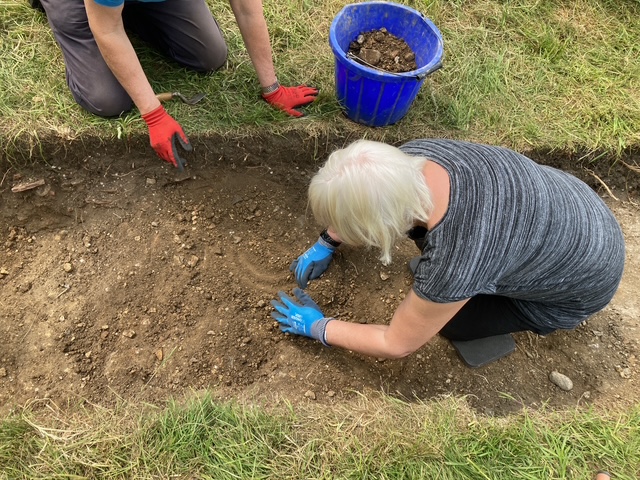Excavation director Simon Coxall gives an update of what happened on Friday 6 June.
In Trench 1 the trackway limits were established and exploration of its junction with the structural foundations to the west has been a little problematic at first. The foundations appear to consist of a dense concretion of sand gravels and small sub-angular flint cobbles rather than the larger flint cobbles that were anticipated. Such larger cobbles as survive are redeposited remnants of the former walls perhaps not though worthy to recover from the demolition.
Subscribe to our quarterly newsletter
There is nearby corroboration of this foundation method from records of when Saffron Walden castle was explored.
‘…Archaeological excavation and monitoring was carried out prior to and during repair work to the retaining wall between the north side of Saffron Walden Castle and the rear of 30 Castle Street. A 1m-wide trench, stepped for safety, was excavated through the deposits to the south of the wall. Natural chalk was exposed in the base of the trench at a depth of c. 2m below the ground surface. This was sealed by buried medieval topsoil upon which were a series of compacted sand, flint and chalk deposits interpreted as the foundations of the mid-14th century inner bailey curtain wall. The foundations were found to extend along the length of the retaining wall during monitoring. ‘
The depth of these foundations has still to be established. Both the foundation and trackway are to be sampled for evidence of construction methods and perhaps phased construction.

In Trench 2 the beam slot found on Wednesday has morphed into a ditch with dark humic fill. At its uppermost levels this contained two sherds of medieval pottery Sandy ware probably for the same vessel estimated as being 14th century. This is being cleaned/defined prior to full excavation of its fill. The ditch encountered at the southern extent of Trench 2 has been excavated and found to contain in the main demolition materials in its upper levels with a medieval jug handle (?) present in the lower fills as presented in the trench’s eastern balk.
The trench has shown the propensity for features hitherto not recorded by geophysics and will be explored further.
A sketch with approximate trench locations is the featured image and courtesy of Simon. The trenches are being georeferenced in with Oxford Archaeology East assistance on Monday. There’s a decision to be made today (Saturday) regarding extension of either trench to achieve the current excavation limit of 2 x c.2m trenches.
